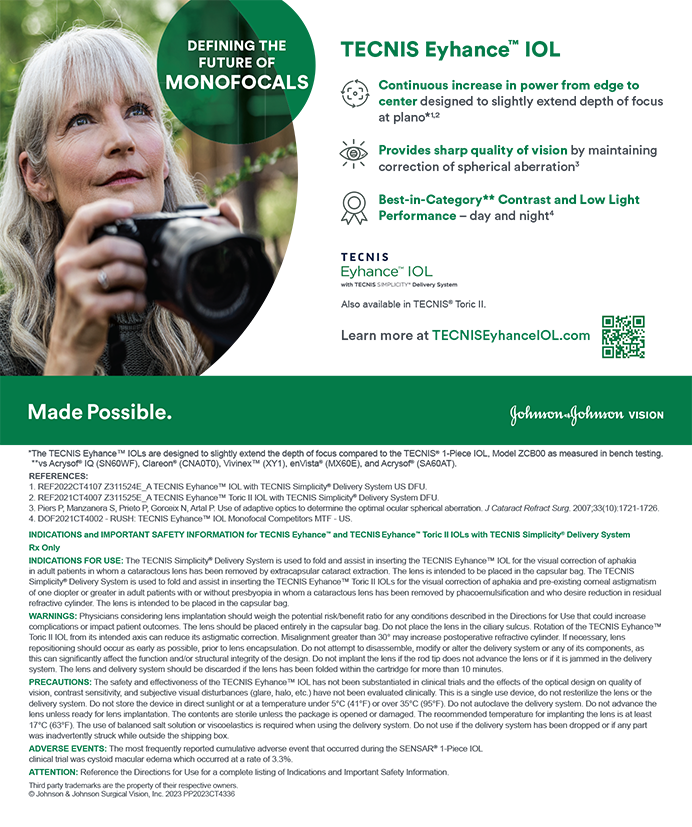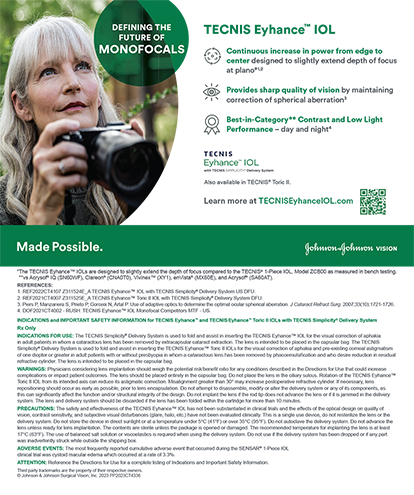
The use of intense pulsed light (IPL) in eye care continues to evolve. What began as an anecdote in the hands of a few has evolved into peer-reviewed empirical science in the hands of many. IPL now stands alongside traditional treatment options for ocular surface disease (OSD) and was included as part of the Tear Film & Ocular Surface Society’s Dry Eye Workshop II treatment algorithm in 2017.1
The use of IPL for the treatment of dry eye disease (DED) remains an off-label application in the United States. However, it has approval for this indication in several other countries. Treatment applications for DED occur only to the skin around the eye, so this aligns nicely with the FDA clearance of IPL for treating inflammatory skin conditions.
Now practitioners of IPL anticipate the next evolutionary stage, when the therapeutic procedure evolves from successful science into a successful business. Many physicians have bought into the technology and the data, and now they are ready to buy into the success. This article highlights five keys to optimize clinical and financial success with IPL.
No. 1: Remember why you purchased IPL. With so many useful treatment options already available for the management of DED, the decision to invest in a device must include three considerations: efficacy, economics, and efficiency. A failure to fulfill any of these three Es will likely result in a failure in your office.
From the perspective of efficacy, the ability of IPL to treat the upstream, inflammatory basis of OSD and DED sets it apart from other device options on the market that instead treat the downstream consequences, such as meibomiam gland inspissation. Furthermore, the antiinflammatory mechanism of action makes IPL treatment relevant to both aqueous-deficient and evaporative DED; meibomian gland dysfunction and rosacea are certainly sufficient to recommend IPL, but they are not necessary. Furthermore, there are anecdotal reports of IPL’s efficacy in treating chalazia, and a recent publication showed, with real-time video, IPL’s ability to eradicate Demodex in vitro.2
No. 2: Adjust your practice’s philosophy. Do your practice’s doctors see DED as an obstacle or an opportunity? This is a key question. If the answer is the former, you can expect mediocre success. Most patients in your practice have risk factors for DED, and, with more than 33 million Americans diagnosed with DED,3 if the opportunity isn’t obvious you are willfully ignoring it.
In this lies the economic side of investing in the IPL device. An unsatisfied DED patient is an unmet opportunity. Whether you are managing a chronically treated DED patient who has not responded to traditional treatments or a newly diagnosed DED patient who reports a dislike for drops, IPL must come to mind.
With every cataract, we at least consider its readiness for surgery. Likewise, with every DED patient, we must at least consider the opportunity for IPL. And all members of the practice must participate in this consideration, not just whoever is the DED champion. Everybody in the practice does not have to perform IPL, but everybody should have knowledge and awareness of it.
No. 3: What you say counts as much as what you do. When implementation of IPL fails to reach its full potential, doctors are often quick to blame a deficiency in the technology, a reluctance on the part of patients, or even a lack of attention from the manufacturer. But, as one would expect, rarely do doctors look toward themselves or their practice for an explanation.
If they did, they would likely realize that the greatest missed opportunity was the opportunity to communicate better with their patients. With IPL, doctors have three chances to say the right thing—before treatment, during treatment, and after treatment. IPL affords doctors a rare 5 to 10 minutes of hands-on treatment time that drops and drugs do not. That together-time can go a long way toward strengthening the doctor-patient relationship and the patient’s experience overall.
How does the doctor introduce the concept of IPL? What about the concept of a cash-pay service for DED? What does the doctor say during the procedure? How does the doctor respond afterward to the satisfied as well as the dissatisfied patient? The words used during these moments are crucial in achieving patient satisfaction. Setting expectations and delivering reassurance are essential components before, during, and after treatment. Good outcomes can go bad and bad outcomes can go worse when the wrong words are used with the right treatment.
No. 4: Revise your treatment technique. This key point deals with the third E, efficiency. For most doctors, initial training on IPL generally consisted of learning the lower lid tragus-to-tragus technique pioneered by Rolando Toyos, MD. This technique involves using a large light guide tip and adhesive ocular shields. It consists of making two passes of light applications at preset parameters, determined in part by skin type. This technique achieves excellent results, but occasionally doctors may seek to enhance their clinical outcomes through technique modifications.
An easy adjustment involves treating not only the lower lids but the upper ones as well. After all, the pathophysiologic basis behind OSD is the same for all four eyelids; why treat only half of them? This modification can be accomplished safely with the use of corneal shields, which permit safe application of the light to both lids of each eye. The Optima IPL (Lumenis) is one IPL system that permits the user to switch the larger light guide tip for a smaller one, allowing more focused application to areas just proximal to the lid margins of both the upper and lower lids.
No. 5: Discover marketing opportunities. Let’s go back to the second E, economics. It comes as a surprise to many doctors that the best marketing strategy for IPL is simply the awareness that the patients are already there. Even if doctors make no additional marketing efforts, DED patients show up at the office. The question is: Do doctors recognize the opportunity?
Every DED patient must be considered a possible candidate for IPL, whether at the beginning or end of the DED algorithm. Routine is one of the greatest impediments to progress. Because of DED’s uniquely high prevalence, the easily formed habits of physicians, and physicians’ fear of added inefficiencies, a routinized approach can stifle active DED management.
Every patient is a marketing opportunity. “Ms. Smith, you have dry eye. Would you be interested in a drug-free, drop-free treatment?” That’s it. Simplicity sells (and keeps the marketing budget down, too).
WATCH IT NOW | IPL VIDEOS ON EYETUBE
CONCLUSION
Although these five tips are meant to help you improve your medical and financial results with IPL, some readers will undoubtedly still question whether their patient population will elect a noncovered, cash-pay DED service. “My patients just aren’t going to spend this kind of money on dry eye,” is the mantra of IPL skeptics.
Believe it or not, the skeptics are right; not all patients can afford a $1,200 DED treatment. However, IPL is not for all of your patients. It’s for some. Premium cataract lens options are not for all patients either, but we still offer them. A successful service does not have to be for all for it to be a success for you.
With Medicare reimbursement for cataract surgery lower than it has ever been, the idea of an in-office procedure that generates more revenue than bilateral routine cataract surgery is at least worthy of consideration. IPL was once one of the great secrets in eye care, but it need no longer be one. The evolution of IPL continues, from secret, to science, to success.
1. Craig JP, Nelson JD, Azar DT, et al. TFOS DEWS II Report Executive Summary. Ocul Surf. 2017;15(4):802-812.
2. Fishman HA, Periman LM, Shah AA. Real-time video microscopy of in vitro Demodex death by intense pulsed light [published online ahead of print, 2020 Jan 27]. Photobiomodul Photomed Laser Surg. 2020;10.1089/photob.2019.4737.
3. The 2015 Gallup Study of Dry Eye Sufferers. Princeton, NJ: Gallup Organization.




